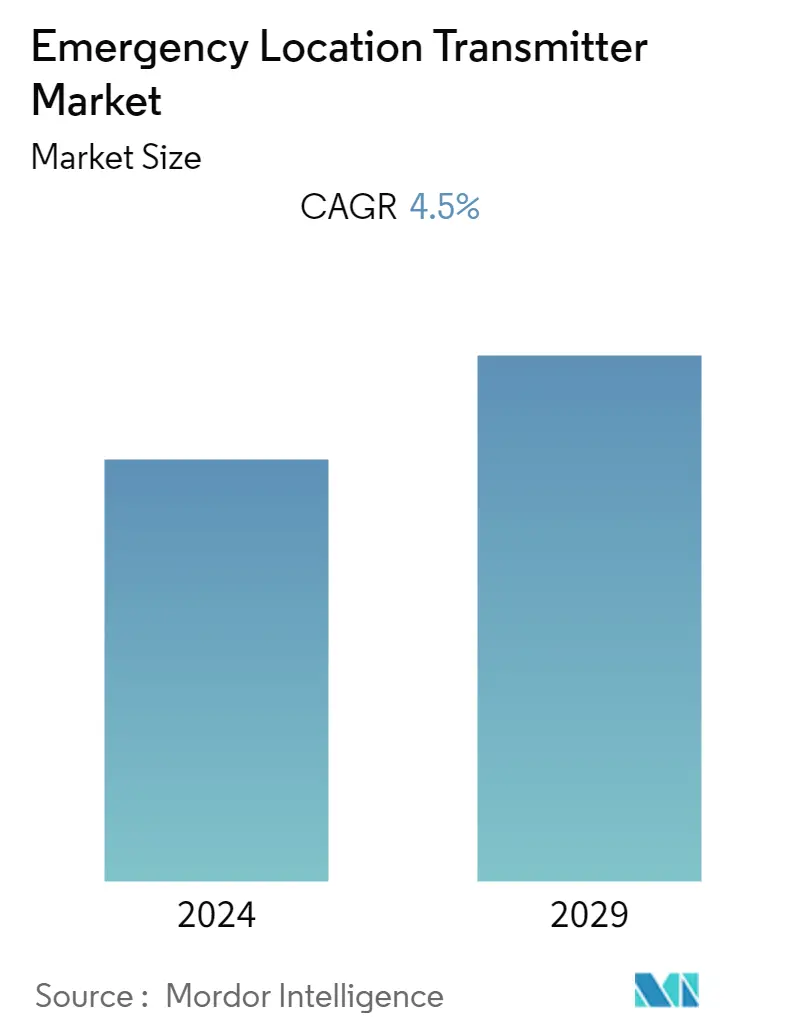Market Size of Emergency Location Transmitter Industry

| Study Period | 2019 - 2029 |
| Base Year For Estimation | 2023 |
| Forecast Data Period | 2024 - 2029 |
| CAGR | 4.50 % |
| Fastest Growing Market | Asia Pacific |
| Largest Market | North America |
Major Players
*Disclaimer: Major Players sorted in no particular order |
Need a report that reflects how COVID-19 has impacted this market and its growth?
Emergency Location Transmitter Market Analysis
The Emergency Location Transmitter Market was valued at USD 149.74 million in 2020 and is expected to reach USD 194.82 million by 2026 and grow at a CAGR of 4.5% over the forecast period (2021-2026). The growth of ELTs was primarily driven by various regulations introduced around the world. Countries like the United States, France, and the United Kingdom were among the first ones to make the installation of ELTs mandatory in several aviation and transportation practices. The globally accepted frequency for ELTs has been set to 406 MHz since 2009. Most countries shifted to this frequency in the early years, but a large part of the developing countries and countries with low penetration of ELT devices still lack such concepts. Reportedly, Mexico was the last country to shift to 406 MHz in December 2018.
- The most significant impact of ELTs is noticed in the rescue operations conducted worldwide. Earlier, it used to take hours to get notified of any incident and the rescue operators had to sweep the suspected area manually, consuming critical time required to attend to the victims. Various regulatory authorities now mandate it in different countries for planes flying in their airspace to be equipped with ELTs for safety purposes. The major aircraft that use these devices include lightweight aircraft, passenger aircraft, and defense aircraft, which constitute a major portion of the world's active air fleet.
- The market for ELTs witnessed a shift from 121.5 MHz ELTs to 406 MHz. For instance, in April 2011, the Federal Communications Commission (FCC) elected to stay a proposed rule that mandated the replacement of 121.5 MHz emergency locator transmitters (ELTs) with 406 MHz ELTs. On March 29, the FCC published a final rule that indefinitely stays its original order regarding ELTs. Such regulations have supported the adoption of 406 MHz ELTs over 121.5 MHz.
- Furthermore, the regular maintenance activities include changing the battery, calibrating the GPS, and inspecting for damages caused by wear and tear factors. If not maintained appropriately, the ELT may not get triggered during an incident or may send false alarms, which attracts enormous fines. Operators tend to replace their ELTs after a specific duration to avoid such events, which is driving the demand for more robust and reliable ELTs.
- ELTs are a minimal component in an aircraft, enabling great safety features. Owing to the benefits offered by this technology, there is a continuous innovation in this domain to make ELTs more compact and highly reliable. Companies, like Orolia, are continually bringing new solutions to the market. Recently, two new next-gen ELTs were launched at the Paris Air Show held in June 2019. Similarly, the marine industry benefited immensely from ELTs. Applications making use of ELTs include offshore oil rigs, cargo vessels, fishing vessels, and other special-purpose recreation boats.
- The ELTs pose significant challenges, such as the inadvertent activation of ELT systems is a serious problem that expends resources and can divert equipment and manpower away from real emergencies. Furthermore, high false alarm rates can desensitize response teams, as they may think the event is not real. While all ELT activations trigger a response from emergency response teams, only a small fraction are real emergencies. Such instances are anticipated to impact the market.
